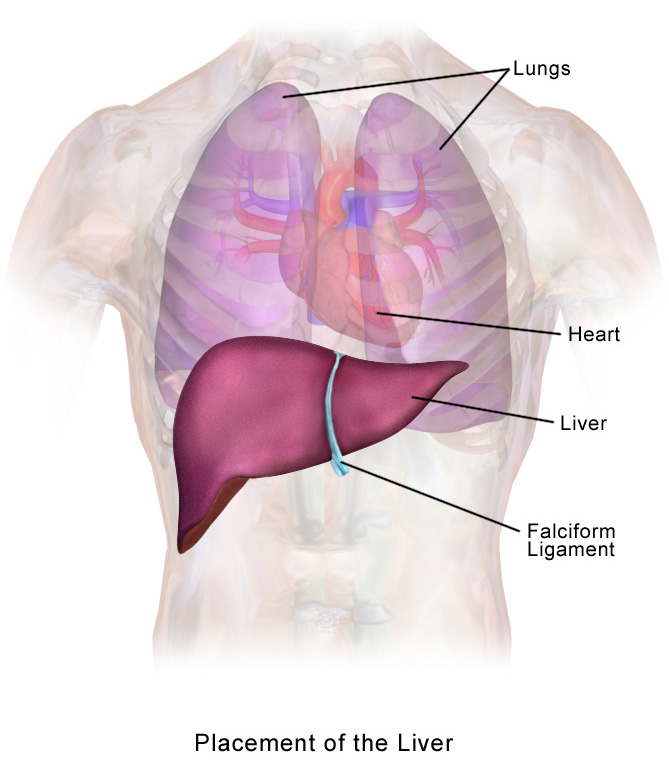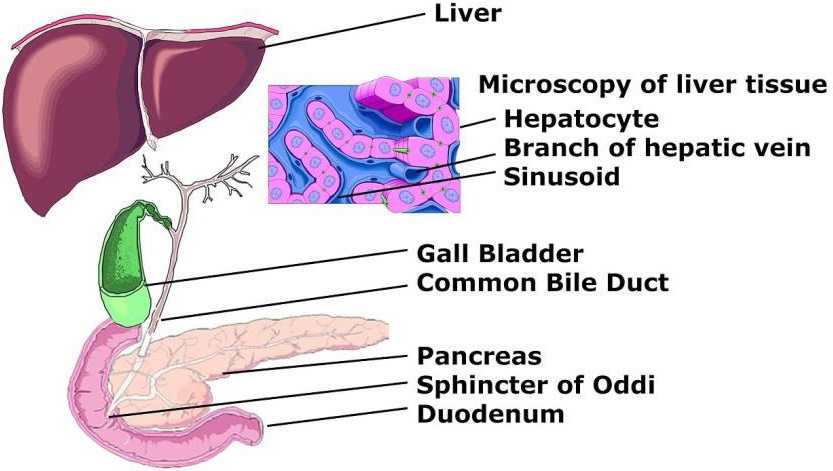Joseph R. Anticaglia MD
Medical Advisory Board
The liver is the largest internal organ in the body. It weighs 3 to 3.5 pounds and is located mainly on the right side of the body below the lungs and diaphragm. It extends approximately from the right fifth rib to the lower border of the rib cage. The sickle shaped falciform ligament separates the liver into the much larger right lobe and a smaller left lobe.
How It Looks — A Glimpse at the Anatomy

Hepatocytes are the cells of the liver. They work 24/7 performing vital functions to keep the body’s engine running smoothly. They’re the liver’s «first responders» playing pivotal roles in detoxification, metabolism and protein synthesis. These cells also have the special ability to repair the liver after it has become injured. For instance, if a portion of the liver is surgically removed, the cells reconstruct the missing tissue.
There is a limit, of course, to how much these regenerative cells can do. It depends on the severity and frequency of the injury. People who habitually abuse the liver cause the cells to burn out leading to problems such as cirrhosis of the liver. At other times, cancer, and other conditions can overrun hepatocytes.
Liver’s Vascularity
At any given moment , the liver houses about one pint of the body’s blood supply. There are two main sources that supply blood to the liver:
- The hepatic artery supplies oxygenated blood to the liver
- The hepatic portal vein supplies nutrient rich food to the liver.
All the blood leaving the intestine and stomach flows through the liver. The liver receives oxygen-rich blood from the heart by way of the aorta and the hepatic artery, which the liver needs to carry out its myriad functions. (see diagrams below).

The hepatic portal vein transports all kinds of stuff from the stomach and intestines to the liver. Some of it is nourishing while other substances may be poisonous. The liver filters and separates the healthy nutrients and substances from harmful poisons. The blood exits the liver by way of the inferior vena cava. Some of the substances in the blood are postmarked for nutrition, while others are directed towards excretion.
Functions of the Liver — How It Works
The liver performs more than five hundred pivotal functions. It filters all the blood in the body; that is, the blood from every part of the body must pass through «checkpoint hepatico» before it reaches the heart. Once the blood is in the liver, it starts the process of utilizing nutrients from our diet and excreting poisons such as drugs from our body. The main functions of the liver can be divided into:
1) Storage Depot
It stores glycogen, vitamins and minerals. At times, the body has circulating glucose in the blood that it doesn’t immediately need. The liver converts glucose to glycogen and places it in storage. Later, glycogen can be changed back to glucose and returned to the blood to be used as energy. The liver stores vitamin D, iron and copper for future use. It also stores the fat soluble vitamins A, D, E, and D. The body needs bile for it to absorb and utilize the ADEK vitamins.
2) Manufacturing Center
Bile Production
Hepatocytes manufacture substances that help the body function at peak efficiency. They secrete, for example, bile acids which eventually are converted to bile which is concentrated and stored in the gallbladder.
Bile drips into the common bile duct on its way to the first portion of the small intestine called the duodenum. Bile breaks down fatty foods and fat soluble vitamins into fatty acids, so the body can digest them. It also destroys microbes, neutralizes excess acids and helps carry away waste material.

In addition, the liver manufactures blood plasma proteins, such as, albumin and blood clotting factors. Albumin transports enzymes, vitamins and minerals in the bloodstream. It prevents these proteins from leaking out of the bloodstream into the surrounding tissue. Clotting factors are needed to stop the bleeding, for instance, from cutting yourself after shaving.
(Stay with me. I know it’s a lot of stuff to «digest.»)
The liver produces cholesterol to help form hormones and vitamin D. It fights infections by manufacturing immune factors that kill bacteria and viruses (natural killer cells) and remove bacteria from the bloodstream. The liver makes bile as noted above.
3) Processing Plant
The liver converts carbohydrates, fats and proteins into products the body can utilize. The liver processes and neutralizes toxins and drugs. It passes them along to the kidneys or intestines for excretion. The liver converts toxic ammonia to urea, which is excreted in the urine. Ammonia is the by-product of protein metabolism. It processes the iron content of hemoglobin.
The liver manages the blood levels of amino acids, which form the building blocks of proteins It helps to excrete bilirubin, which is formed by the breaking down of old, red blood cells (hemolysis). The accumulation of bilirubin turns the eyes and skin yellow. The liver helps to dispose of neutralized, dead bacteria from the body.
4) Waste Management
The liver plays a vital role in cleansing the body of waste materials. It detoxifies drugs and toxins from the blood and channels the by-products to the kidneys and intestines for excretion. Bilirubin, the waste product of the breakdown of hemoglobin, is eventually excreted in the large intestine with the stool. The kidneys filter out blood products and they leave the body as urine. Bile by-products enter the intestine and exit as feces.
The liver acts like a filter — metabolizing nutrients while rejecting and eliminating toxins. It actively participates in almost every organ system. At the center of this activity is the hepatocyte, the essential cell of the liver. The liver manufactures, processes and store proteins as well as helping to eliminate waste products. It has the capacity to regenerate itself. The liver is a remarkable, underappreciated organ that often flies under the radar.
Glossary
Hepatic lobule is a small lobe or subdivision of the hepatic lobe. It’s the functional part of the liver, consisting of a cluster of hepatocytes, a central vein and the portal triad, i. e., the hepatic artery, portal vein and bile duct. It’s also the building unit of the liver.

References
- Sherif R. Z. Abdel-Misih, MD and Mark Bloomston, MD.
- The Liver; Lumen
- Physiology, Liver; Stat Pearls
This article is intended solely as a learning experience. Please consult your physician for diagnostic and treatment options.

